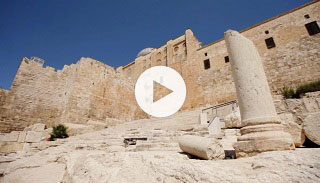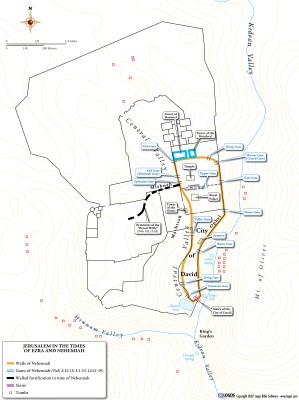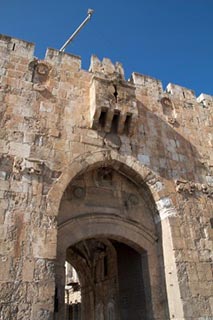3:1–32 This section describes the rebuilding of the Jerusalem wall, which begins at the northeast corner and moves around the city in a counterclockwise direction: the north wall (vv. 1–5); west wall (vv. 6–13); south wall (vv. 14–15); east wall (vv. 16–31); and the eastern stretch of the north wall (v. 32). In some places, the wall needed to be built from the ground up; in other places, repairs needed to be made to the existing wall. The description centers on the 10 gates of the city: the Sheep Gate (vv. 1, 32); the Fish Gate (v. 3); the Jeshanah (or Old) Gate (v. 6); the Valley Gate (v. 13); the Dung Gate (v. 14); the Fountain Gate (v. 15); the Water Gate (v. 26); the Horse Gate (v. 28); the East Gate (v. 29); and the Inspection (or Muster) Gate (v. 31). Since the gates were the most vulnerable sections of ancient walls, these were the most important segments of the project. The exact location and extent of Nehemiah’s wall is unknown. If the wall enclosed the southwest hill known as “Mount Zion,” the wall would have been about two-and-a-half miles long, enclosing about 220 acres. If the hill was outside the walls, the wall would have been a little less than two miles long, enclosing about 90 acres. |
3:1 Eliashib The grandson of Jeshua (also called Joshua), the high priest during the time of Zerubbabel’s rebuilding projects (Ezra 3:2).
the Sheep Gate Located at the northeastern corner of the wall, near the Pool of Bethesda (John 5:2). The gate probably took its name from the sheep that were brought through it to be offered on the altar at the nearby temple. There may have been a market there where sheep were sold for sacrifice. The Sheep Gate may have been the same as the Benjamin Gate (Jer 20:2; 37:13).
the Tower of the Hundred The headquarters for the commander of a company of 100 men.
the Tower of Hananel Located at the northernmost part of the wall (Zech 14:10). Herod’s Antonia fortress was probably located on the same site (see the work of the Jewish historian Josephus, Jewish Wars, 5.238).
3:2 next to him The first part of this chapter (Neh 3:1–15) is joined together by frequent occurrences of the phrases “next to him” or “next to them.”
3:3 the Fish Gate Near the northwest corner of the city, possibly close to a fish market.
3:4 Meremoth One of the leaders of the priests (Ezra 8:33). He is mentioned later as repairing a second section of the wall (Neh 3:21).
Meshullam The father-in-law of Jehohanan, the son of Tobiah (6:17–18).
3:5 Tekoites The city of Tekoa was located about 12 miles south of Jerusalem in an open plain in the Judaean wilderness. It was the home of the prophet Amos (Amos 1:1).
nobles did not put their neck to the work of their lord The only time in this passage where individuals are identified as refusing to participate in the rebuilding project. The leaders of the city may have anticipated the opposition to the rebuilding project, and they did not want to join ranks with Nehemiah, thereby giving opponents a reason to attack their city. The men of Tekoa seem to have compensated for the faults of their nobles by repairing two sections of the wall (Neh 3:27).
lord The Hebrew word used here is plural and can be understood as referring to God (in which case the translation would be “Lord”) or to human masters (in which case the translation would be “masters” or “supervisors”).
3:6 the old Yeshanah Gate The name of this gate can be translated “Old” or transliterated as “Jeshanah.” If it is the latter, then it likely refers to a town of that name near Bethel (2 Chr 13:19).
3:7 the Gibeonite The city of Gibeon was located about six miles northwest of Jerusalem.
Mizpah Located about eight miles north of Jerusalem.
who were under the rule of the governor of The meaning of this phrase is unclear, because the Hebrew word kisse used here could refer to a seat (a physical site of authority) or to authority. It likely refers to Mizpah as the official residence of the provincial governor when he visited Judah (for Mizpah as an administrative center, see 2 Kgs 25:23; Jer 40:5–12).
3:8 goldsmiths Individuals skilled in working with gold and silver. Their primary product was jewelry, though they were also called upon to fashion utensils, bowls, dishes, and a variety of other articles (Ezra 1:9–11).
Broad Wall Located between the Ephraim Gate and the Tower of the Ovens (Neh 12:38–39).
3:9 commander of half Jerusalem was divided into two districts, each governed by an official.
3:10 opposite his house Nehemiah assigned workers to repair areas near where they lived or worked.
3:12 his daughters Since he is the only one whose daughters are mentioned, Shallum may have had no sons.
3:13 Zanoah Located about 14 miles southwest of Jerusalem in the southern hill country of Judah (Josh 15:34).
a thousand cubits About 1,500 feet.
3:14 the district of Beth-haccherem Modern Ramat Rachel, located two miles south of Jerusalem.
3:15 the Pool of Shelah Probably the same as the King’s Pool (see note on Neh 2:14).
the king’s garden Probably located near the southeastern corner of the wall.
3:16 After him The sections in the remainder of the chapter are joined by the Hebrew term acharai, meaning “after him.” See note on v. 2.
the district of Beth Zur Located about 13 miles south of Jerusalem and about four miles north of Hebron.
the house of the mighty warriors This may have been a military barracks; the name associates it with David’s mighty men (2 Sam 23:8–39).
3:17 the district of Keilah Located about 15 miles southwest of Jerusalem.
3:18 Bavvai son of Henadad Most Hebrew manuscripts read “Bavvai” here, but it most likely refers to the Binnui of Neh 3:24 and 10:9. The name Bavvai is unknown in Hebrew. Verse 24 also states that Binnui repaired another section, implying that he had previously completed a different one—likely the section mentioned here.
3:25 the courtyard of the guard The site where King Zedekiah imprisoned the prophet Jeremiah
imprisoned the prophet Jeremiah for prophesying that Jerusalem would fall to the Babylonians and that he would be taken captive by Nebuchadnezzar (Jer 32:2).
for prophesying that Jerusalem would fall to the Babylonians and that he would be taken captive by Nebuchadnezzar (Jer 32:2).
3:26 Ophel The beginning of the hill on which the temple was located (see 2 Chr 27:3; 33:14).
the Water Gate Located near the Gihon spring, the main water source for Jerusalem.
3:27 the wall of Ophel An internal wall running from east to west that divided the city of David in the south from the Temple Mount in the north (2 Chr 27:3).
3:28 the Horse Gate The easternmost part of the city (Jer 31:40) overlooking the Kidron Valley. This gate may have been an entrance for cavalry into the palace courtyard.
3:29 the East Gate Probably a gate of the temple court, not a gate of the city wall.
3:30 his room Possibly a chamber of the temple (Neh 12:44; 13:7).
3:31 the upper room of the corner Probably a watchtower situated at the northeastern corner of the city.

|
About Faithlife Study BibleFaithlife Study Bible (FSB) is your guide to the ancient world of the Old and New Testaments, with study notes and articles that draw from a wide range of academic research. FSB helps you learn how to think about interpretation methods and issues so that you can gain a deeper understanding of the text. |
| Copyright |
Copyright 2012 Logos Bible Software. |
| Support Info | fsb |
 Loading…
Loading…




